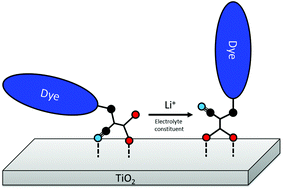Dye⋯TiO2 interfacial structure of dye-sensitised solar cell working electrodes buried under a solution of I−/I3− redox electrolyte†
Abstract
Dye-sensitised solar cells (DSCs) have niche prospects for electricity-generating windows that could equip buildings for energy-sustainable future cities. However, this ‘smart window’ technology is being held back by a lack of understanding in how the dye interacts with its device environment at the molecular level. A better appreciation of the dye⋯TiO2 interfacial structure of the DSC working electrodes would be particularly valuable since associated structure–function relationships could be established; these rules would provide a ‘toolkit’ for the molecular engineering of more suitable DSC dyes via rational design. Previous materials characterisation efforts have been limited to determining this interfacial structure within an environment exposed to air or situated in a solvent medium. This study is the first to reveal the structure of this buried interface within the functional device environment, and represents the first application of in situ neutron reflectometry to DSC research. By incorporating the electrolyte into the structural model of this buried interface, we reveal how lithium cations from the electrolyte constituents influence the dye⋯TiO2 binding configuration of an organic sensitiser, MK-44, via Li+ complexation to the cyanoacrylate group. This dye is the molecular congener of the high-performance MK-2 DSC dye, whose hexa-alkyl chains appear to stabilise it from Li+ complexation. Our in situ neutron reflectometry findings are built up from auxiliary structural models derived from ex situ X-ray reflectometry and corroborated via density functional theory and UV/vis absorption spectroscopy. Significant differences between the in situ and ex situ dye⋯TiO2 interfacial structures are found, highlighting the need to characterise the molecular structure of DSC working electrodes while in a fully assembled device.



 Please wait while we load your content...
Please wait while we load your content...